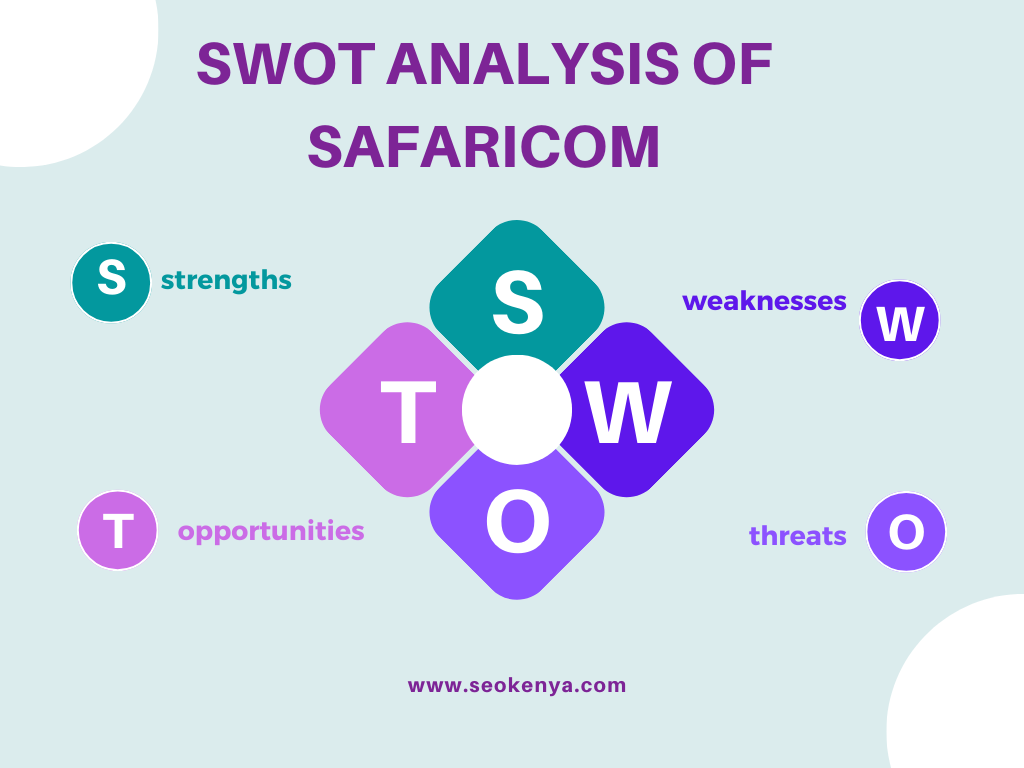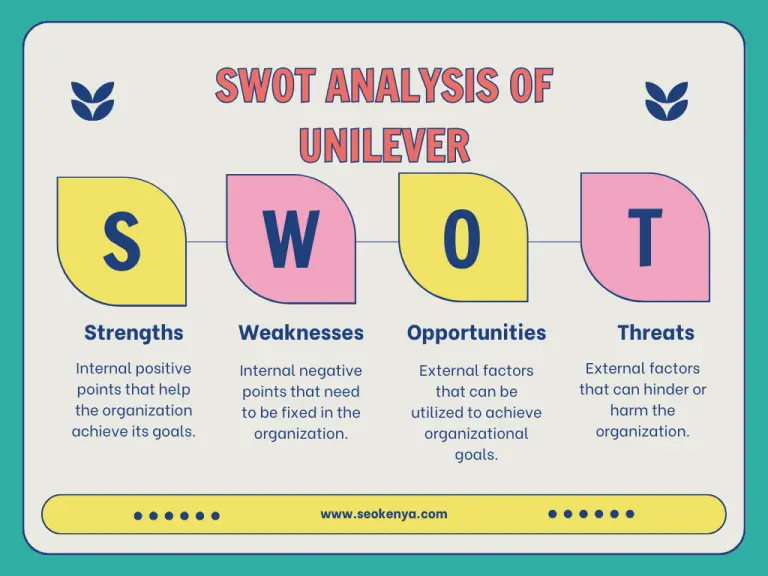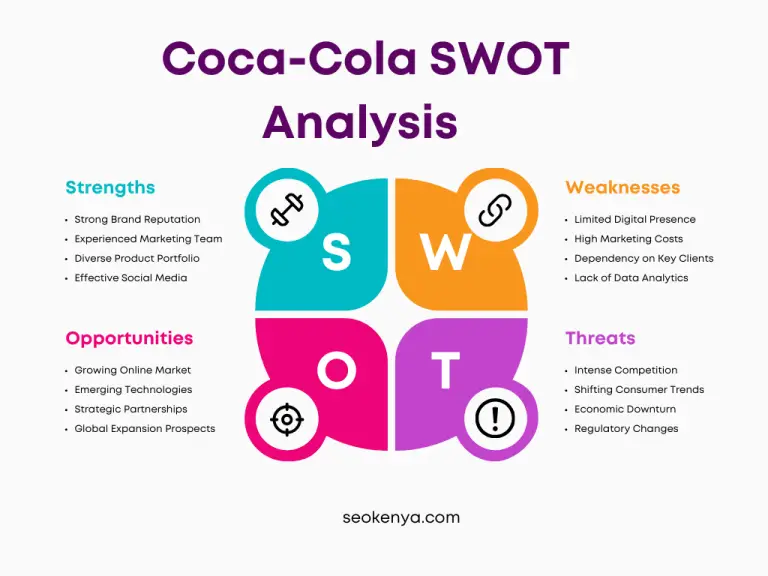In-Depth SWOT Analysis of Safaricom
Did you know that Safaricom, the leading telecommunications company in Kenya, has over 35 million subscribers, accounting for more than 60% of the country’s mobile market share?
This staggering statistic showcases the immense impact and influence that Safaricom holds in the Kenyan telecommunications industry.
Overview of Safaricom Company:
CATEGORY |
DETAILS |
| Company Name | Safaricom PLC |
| Headquarters | Nairobi, Kenya |
| Founded | 1997 |
| Industry | Telecommunications |
| Key Products/Services | Mobile Voice, Mobile Data, Mobile Money Transfer (M-PESA), Fixed Data and Internet, Digital Services |
| Revenue (FY 2022) | KES 298.1 billion ($2.5 billion) |
| Net Income (FY 2022) | KES 68.7 billion ($576 million) |
| Employees | ~6,000 (as of 2022) |
| CEO | Peter Ndegwa (since April 2020) |
| Market Capitalization | ~$11 billion (as of March 2023) |
| Ownership | 35% owned by the Kenyan Government, 40% owned by Vodafone Group Plc, 25% publicly traded |
| Subscriber Base | Over 42 million customers (as of 2024) |
| Key Subsidiaries | M-PESA, DigiFarm, Masoko (e-commerce platform) |
| Market Share | ~65% of the Kenyan mobile market (as of 2022) |
In this comprehensive SWOT analysis, we will delve into Safaricom’s strengths, weaknesses, opportunities, and threats, analyzing the external factors that shape its business landscape and market positioning.

By understanding these key factors, we can gain valuable insights into how Safaricom maintains its competitive edge and strategizes for future growth.
Key Takeaways:
- Despite fierce competition, Safaricom dominates the Kenyan telecommunications market with over 35 million subscribers.
- Safaricom’s strengths include its strong brand identity, extensive network coverage, and financial stability.
- Challenges such as regulatory constraints and operational inefficiencies pose potential weaknesses for Safaricom.
- Safaricom has opportunities to capitalize on emerging trends, technological advancements, and potential market expansion.
- Threats to Safaricom include intense competition, evolving customer preferences, and regulatory changes.
Safaricom’s Strengths
In this section, we will explore the core strengths of Safaricom, which contribute to its competitive advantage and strategic positioning in the Kenyan telecommunications industry.
By understanding these strengths, we gain valuable insights into Safaricom’s business analysis and its ability to navigate the opportunities and threats in the market.
- Market Position: Safaricom enjoys a dominant market position in Kenya, holding the largest market share in terms of subscribers, revenues, and network coverage. This strong presence enables Safaricom to leverage economies of scale and establish itself as a key player in the industry.
- Financial Stability: With consistent revenue growth and profitability over the years, Safaricom exhibits financial stability. This financial strength allows the company to invest in infrastructure development, innovation, and expanding its service offerings.
- Strong Brand Identity: Safaricom has built a strong brand identity and enjoys high brand recognition among consumers. Its brand is synonymous with reliability, innovation, and quality, enhancing customer trust and loyalty.
- Customer Loyalty: Safaricom’s customer base showcases exceptional loyalty. The company has successfully cultivated a positive customer experience through its reliable network, innovative services, and customer-centric approach, resulting in a low churn rate and high customer retention.
- Extensive Network Coverage: Safaricom boasts a widespread network coverage across Kenya, including both urban areas and remote regions. This extensive reach allows Safaricom to tap into underserved markets, expand its customer base, and provide seamless connectivity to its subscribers.
- Leading Role: Safaricom plays a leading role in driving innovation and technological advancements in the Kenyan telecommunications industry. The company continuously introduces new products, services, and solutions that cater to the evolving needs of its customers, staying ahead of the competition.
By capitalizing on these strengths, Safaricom has positioned itself for success in a competitive market, ensuring continued growth and sustainability.
Safaricom’s Weaknesses
As we delve into Safaricom’s business analysis, it is crucial to assess the weaknesses that the company faces. These weaknesses present areas of potential improvement and risks that Safaricom needs to address to maintain its market position.
1. Regulatory Constraints
Safaricom operates in a highly regulated industry, which can pose challenges for the company. Regulatory constraints such as policies, licensing requirements, and compliance obligations can restrict Safaricom’s operations and financial decisions.
These constraints may limit the company’s flexibility and innovation, hindering its ability to respond quickly to market changes and customer demands.
2. Dependency on the Kenyan Market
While Safaricom has established itself as a dominant player in the Kenyan telecommunications market, its heavy reliance on this single market exposes it to potential risks.
Economic downturns, political instability, or changes in government policies could significantly impact Safaricom’s revenue and profitability. Diversifying its operations and expanding into new markets can help mitigate this vulnerability.
3. Potential Vulnerabilities in Infrastructure
As a telecommunications provider, Safaricom’s infrastructure is the backbone of its services. Any weaknesses or vulnerabilities in its network infrastructure could result in service disruptions or security breaches, impacting customer experience and eroding trust.
Continuous investment in infrastructure upgrades, cybersecurity measures, and disaster recovery plans is necessary to minimize such risks.
4. Operational Inefficiencies
Like any large organization, Safaricom may encounter operational inefficiencies that can impact its overall performance. These inefficiencies could include complex internal processes, redundant workflows, or inadequate resource allocation. By streamlining operations, optimizing workflows, and leveraging technology, Safaricom can improve efficiency, reduce costs, and enhance customer satisfaction.
| Safaricom’s Weaknesses | |
|---|---|
| Weakness | Potential Impact |
| Regulatory Constraints | Limitations on flexibility and innovation |
| Dependency on the Kenyan Market | Risk of economic downturns and policy changes |
| Potential Vulnerabilities in Infrastructure | Service disruptions and security breaches |
| Operational Inefficiencies | Impact on performance and customer satisfaction |
By acknowledging and addressing these weaknesses, Safaricom can mitigate risks and enhance its overall business performance. In the next section, we will explore the opportunities that Safaricom can capitalize on to further strengthen its market presence.
Opportunities for Safaricom
Safaricom, the leading telecommunications company in Kenya, has several opportunities that it can leverage to further strengthen its market presence and drive growth. By proactively capitalizing on these opportunities, Safaricom can solidify its position as a key player in the industry and enhance its strategic planning.
Trends in the Telecommunications Industry
The telecommunications industry is constantly evolving with emerging trends and technologies. Safaricom can seize the opportunity to stay ahead of the curve by closely monitoring and adapting to these trends.
By embracing advancements such as 5G technology, Internet of Things (IoT), and cloud computing, Safaricom can enhance its network infrastructure and provide innovative services to meet the evolving demands of its customers.
Potential Expansion into New Markets or Services
Expanding into new markets or venturing into related services can open new avenues of growth for Safaricom. With its strong brand identity and expertise in the telecommunications sector, Safaricom can explore opportunities to enter adjacent industries such as mobile financial services, e-commerce, or digital content streaming. Diversification can help Safaricom reduce dependency on its core business and tap into new revenue streams.
Partnerships and Collaborations
Forming strategic partnerships and collaborations can provide Safaricom with additional opportunities for growth and innovation. By joining forces with other industry leaders, Safaricom can leverage their expertise, resources, and market reach to offer new value-added services or expand its customer base. Collaborations with technology companies, content creators, or financial institutions can unlock synergies and create new business opportunities.
| Opportunities | Benefits |
|---|---|
| Investment in 5G technology | Enhanced network capabilities and faster internet speeds |
| Expansion into mobile financial services | Additional revenue streams and increased customer loyalty |
| Collaboration with e-commerce platforms | Access to a wider customer base and increased market share |
| Partnerships with content streaming companies | New revenue streams and enhanced customer experience |
By strategically analyzing and pursuing these opportunities, Safaricom can continue to innovate and adapt to the changing landscape of the telecommunications industry. By leveraging its strengths and addressing its weaknesses and threats, Safaricom can position itself as a market leader and create a sustainable future.
Threats to Safaricom
Safaricom, being one of the leading telecommunication operators in Kenya, faces several threats that could impact its market positioning. One of the key threats is intense competition from other telecom operators in the industry. Safaricom operates in a highly competitive market where rivals constantly strive to gain an edge and attract customers.
Additionally, regulatory changes pose another significant threat to Safaricom. Government policies and regulations can impact the telecom sector, affecting Safaricom’s operations and profitability. It is crucial for Safaricom to stay updated on any regulatory developments and adapt its strategies accordingly to ensure compliance and mitigate potential risks.
Economic uncertainties also pose a threat to Safaricom. Fluctuations in the Kenyan economy, inflation, and changes in consumer spending patterns can affect the demand for telecom services. Safaricom must closely monitor economic indicators and consumer behavior to adapt its offerings and pricing strategies to remain competitive and financially resilient.
Lastly, evolving customer preferences and technological advancements are threats that Safaricom needs to address. As technology advances and customer expectations change, Safaricom must continuously innovate and offer relevant services to meet customer demands. Failure to adapt to these evolving trends could lead to a loss of market share and decreased customer loyalty.
SWOT Analysis of Safaricom
Strengths |
Weaknesses |
Opportunities |
Threats |
|---|---|---|---|
| Strong Market Presence | Dependence on Kenyan Market | Expansion into New Markets | Regulatory Changes |
| Diversified Product Portfolio | Reliance on Mobile Money | Growth in Mobile Money Services | Competition from Telcos |
| Robust Network Infrastructure | Vulnerability to Economic Changes | Technological Advancements | Cybersecurity Risks |
| Brand Recognition | Limited International Presence | Partnerships and Collaborations | Political Instability |
| High Customer Loyalty | Reliance on M-Pesa Revenue | Diversification into Financial Services | Market Saturation in Kenya |




